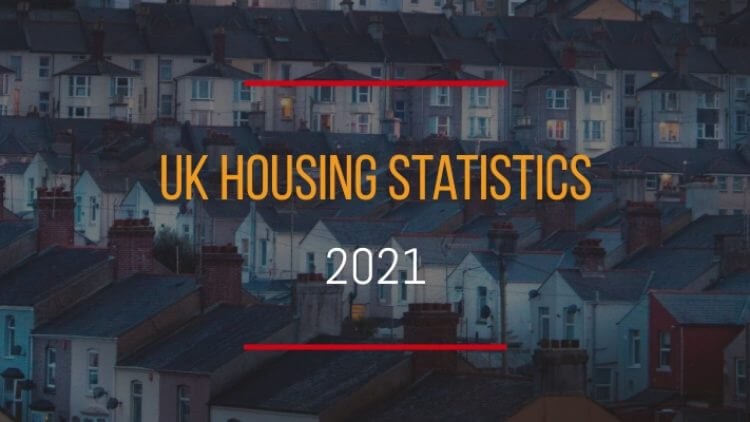December 2020 saw yearly average house prices rise by 8.5%, the highest percentage increase since October 2014. This has mostly been due to the Stamp Duty Land Tax (SDLT) holiday which has encouraged sellers to increase asking prices thanks to reduced purchasing costs.
The average UK house price is now around £252,000, an almost £100,000 increase in the last 10 years.
Average house prices in England
- House prices in England grew by 8.5% in the year to December 2020. The current average value stands at £269,000.
- This represents an average increase of £21,000 per home.
Average house prices in London
- In November 2020, the average house price in London rose over £500,000 for the first time in history, however, London prices closed out the year at £496,000.
- London prices grew by 3.5% in the year to December 2020, which was the lowest growth rate of any region in the UK.
Average house prices in Wales
- Houses in Wales saw the steepest increase in price, growing by 10.7% in the year to December 2020.
- The average house in Wales currently costs £184,000, a record high for the region.
Average house prices in Scotland
- Scotland’s house prices grew by 8.4%, close to the national average.
- The average property in Scotland costs £163,000 as of December 2020, this is slightly down from the peak of £164,000 in November 2020.
Average house prices in Northern Ireland
- Northern Ireland is still the cheapest country in the UK to purchase a house in, with the average house price ending 2020 at £148,000.
- This represents a 5.3% increase over the year to quarter 4, as Northern Ireland’s house price data is collected quarterly, unlike the other countries of the union.
Covid impact on sales
The measures introduced last March to curb the spread of coronavirus had a significant impact on house sales as most sales were prohibited during the initial lockdown. However, the pent-up demand following this period, as well as the Stamp Duty holiday and savings from reduced commutes and closed bars and restaurants actually resulted in more mortgage approvals than 2019.
The Stamp Duty holiday means any property below the value of £500,000 is no longer required to pay the additional tax when purchased. Previously the SDLT threshold was £125,000. The scheme is expected to end in April 2021, meaning any property purchase not completed by March 31st will again be subject to the lower threshold.
Average house price per region
House prices grew the most in the North West, where the average property is 11.2% more expensive than it was in December 2019. London saw the lowest growth at 3.5% but London remains the most expensive place to buy property in the UK.
Cheapest Counties
| Rank | Local Authority | Average House Price | Y-O-Y Change |
| 1 | Blaenau Gwent | £90,000 | +1 |
| 2 | Burnley | £95,000 | -1 |
| 3 | Hyndburn | £110,000 | – |
| 4 | Pendle | £112,500 | +4 |
| 5 | Merthyr Tydfil | £115,000 | +2 |
| 5 | Rhondda Cynon Taff | £115,000 | New |
| 6 | Blackpool | £118,000 | +4 |
| 7 | County Durham | £119,000 | -3 |
| 8 | Stoke-on-Trent | £120,000 | New |
| 8 | Kingston upon Hull | £120,000 | New |
| 8 | Blackburn with Darwen | £120,000 | New |
Blaenau Gwent takes over from Burnley as the cheapest area of England and Wales to buy a house in 2020. New entrants to the cheapest areas include Rhondda, Stoke on Trent, Hull and Blackburn.
Most Expensive Counties
| Rank | Local Authority | Average House Price | Y-O-Y Change |
| 1 | Kensington and Chelsea | £1,275,000 | – |
| 2 | Westminster | £989,995 | – |
| 3 | City of London | £815,000 | – |
| 4 | Camden | £788,000 | – |
| 5 | Hammersmith and Fulham | £740,000 | – |
| 6 | Wandsworth | £743,500 | +4 |
| 7 | Hackney | £640,460 | New |
| 8 | Richmond upon Thames | £640,000 | -2 |
| 9 | Islington | £620,000 | -2 |
| 10 | Elmbridge | £574,342 | -2 |
Mostly unchanged in the most expensive areas of England and Wales, with only one new entrant, Hackney, which has seen an increase of almost £100,000 in the year ending June 2020.
Elmbridge in Surrey is the only area outside of London to make the top 10.
Repossession Statistics
The coronavirus crisis has resulted in a ban on mortgage lenders enforcing repossessions, other than in exceptional circumstances, to avoid housing insecurity and homelessness during the pandemic.
As a result, there were more than 2,000 fewer repossessions in 2020 for the period Jan-Oct as in the previous year. The number of repossessions in England and Wales in 2020 was 4,436.
Repossessions were highest in the North West, where 911 were carried out during the whole of 2020.
Data shows the period January-October for each year 2016-2020.
Mortgage statistics
The number of mortgage approvals in 2020 was 818,500, a 3.7% increase. This is the largest number of approvals in a single year since 2007.
Net mortgage borrowing in 2020 totalled £43.3 billion, a significant drop from 2019, where net borrowing totalled £48.1 billion.
Approvals for remortgaging stood at 451,400 in the year to December 2020, down by 23% compared with the 587,600 approved in 2019.
First-time buyers
The English Housing Survey 2019-2020 found that there were 827,000 first time buyers in England, 100,000 more than the previous year.
The average age of a first-time buyer in the UK has fallen from 33 in 2018-2019 to 32 in 2019-2020.
The average deposit for first-time buyers was £42,433, a 12.6% drop from the previous period.
The number of first time buyers relying on savings to pay their deposit has grown slightly in the past year, while the number using a gift or loan from friends or family has dropped in 2020.
Sources
- https://www.bankofengland.co.uk/statistics/money-and-credit/2020/december-2020
- https://www.ons.gov.uk/
- https://www.gov.uk/government/collections/english-housing-survey







